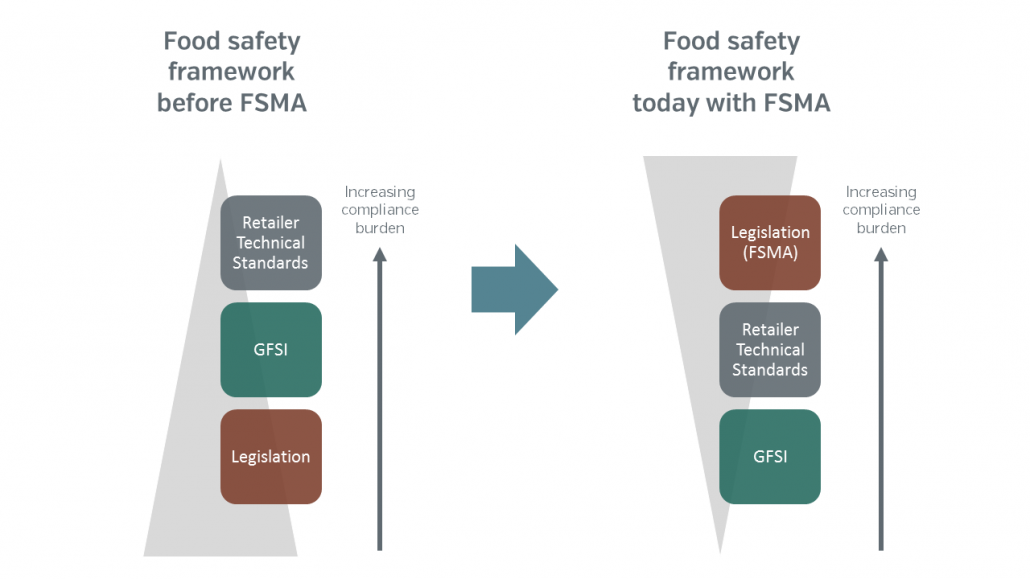The potential impacts of FSMA on the GFSI Scheme
In the 90’s, the food industry was rocked by one food safety crisis after another, such as BSE, Dioxin, and Listeria. Consumer confidence was effectively in the tank, and food companies were becoming desperate for help.
The world’s leading food safety experts from manufacturing, retail, and food service, as well as service providers from within the food supply chain, engaged in a collaborative effort to improve food safety, and the Global Food Safety Initiative (GFSI) was launched in May of 2000.
Fast forward to 2007, to what was referred to as the “GFSI Breakthrough,” when 7 of the world’s major retailers accepted GFSI benchmarked food safety schemes.
At the time, I happened to be working for a large food manufacturer, and I recall hearing GFSI certification being mentioned in a few circles, but it wasn’t causing any concern or raising too many eyebrows.
GFSI wasn’t causing any concern or raising too many eyebrows. That is, until the notification had a Wal-Mart letterhead at the top of the page.
That is, until the notification had a Wal-Mart letterhead at the top of the page and required certification by a specific date.
A collective gulp echoed throughout the country’s major food manufacturers as the reality of becoming certified to a GFSI standard started to set in.
A collective gulp echoed throughout the country’s major food manufacturers as the reality of becoming certified to a GFSI standard started to set in.
The eyes of plant managers and controllers across the country began to glaze over as they started calculating the cost of compliance, because GFSI was not only a new hoop to jump through, it was bigger and higher than all the others and would be more difficult.
What is the GFSI
You might have heard it asked, or even asked the question yourself, “What is GFSI?”
The vision and mission of the GFSI is to provide safe food for consumers by continuously improving food safety management systems, as well as to restore and ensure confidence in the delivery of safe food worldwide.
The GFSI is not a tangible entity which bestows certification upon a deserving food manufacturing facility. It is appropriate to think of it as the resulting set of food safety standards from the think-tank which comprises the organization.
The GFSI has reviewed, assessed, and accredited several schemes which meet the GFSI criteria. Within food manufacturing, the main accredited schemes are the BRC Global Standards, SQF, FSSC2200, and IFS.
These accredited schemes provide 3rd-party audits to food manufacturers and issue certifications to those who pass the certification audit.
Prior to the GFSI, there were several food safety standards, along with 3rd-party auditing companies, but the objectives seemed to be as diverse as the standards themselves.
One could peel back another layer of the 3rd-party auditors and find that individual auditors, working for the same company, might interpret the standards in different ways.
Prior to the GFSI… individual auditors, working for the same company, might interpret the standards in different ways.
Sometimes, to prepare for the audit, you had to know which auditor was going to be present.
The GFSI emerged from the “Mad Cow” rubble with the hope that one audit would replace the other dozens or more a facility might be subjected to during a given year.
Although there has been a reduction in the number of standards and certifications which might be required, most companies I have spoken with over the past few years haven’t necessarily seen the reduction in audits they were hoping for.
However, the GFSI certifications have certainly become somewhat of a gold standard for companies.
GFSI certifications have certainly become somewhat of a gold standard for companies.
New kid on the block: FSMA
Less than a decade after the GFSI hit the shores of the United States, the FDA released the final rules to FSMA. If the GFSI hoop was bigger and higher than all the others, FSMA lit the hoop on fire.
If the GFSI hoop was bigger and higher than all the others, FSMA lit the hoop on fire.
When the GFSI came onto the scene, if your programs were squared with the current legislation, then the chances were good that you would only need to make some improvements to your systems to comply with GFSI requirements.
Today, if your systems were compliant with the GFSI standards, then the chances are good that you only need to make a few improvements to become compliant with FSMA.
Both the GFSI and FSMA focus on systems that recognize and prevent food safety risks and issues before they happen as opposed to simply reacting to them once they occur.
Both the GFSI and FSMA focus on systems that recognize and prevent risk and issues before they happen as opposed to reacting to them.
The scope of the GFSI certification schemes takes a holistic look at a company’s entire supply chain from ingredient receipt to final product shipment.
If a company took this approach, and could meet the GFSI requirements, they would be prepared to handle the increased demands of FSMA, which will broaden the focus of supplier compliance to include not only domestic, but foreign suppliers as well.
With the release of FSMA, the FDA now requires that companies have a Qualified Individual (QI), who has received formal training or is otherwise qualified through job experience.
The final rule for the current Good Manufacturing Practices (cGMP), and requirements for Hazard Analysis and Risk-Based Preventive Controls (HARPC) for Human Food was issued in September 2015 with some significant changes.
The definition for Qualified Individuals has a much broader implication in that it affects all personnel, including operators, supervisors, and Preventive Control Qualified Individuals (PCQI), who must attend FDA-recognized training currently provided by the Food Safety Preventive Control Alliance (FSPCA) or be otherwise qualified through job experience to develop and apply a food safety system.
So, what might FSMA mean for the GFSI in the future?
When the GFSI concept was originally sold to North American concepts back in the second half of the last decade, a GFSI certification was supposed to replace the dozens (and in some cases, even more!) audits that food manufacturers are subjected to.
This quickly proved to not always be the case, as many customers and regulatory bodies still insist that food companies pass their audit, which in many cases might include the requirement of GFSI certification.
That logic could arguably be considered circular, but the fact remains, it is a hoop that must be jumped through!
In February, I attended the GFSI conference in Houston and learned that regulators are starting to accept GFSI certifications as supplemental risk assessments as they are so intensive and full of checks and balances that they ultimately steer a company into a high level of food safety management.
Given the climate of the current political administration, this could prove to become an even more common practice should President Trump fulfill his campaign promise to reduce the size of the FDA.
Many companies found that meeting the GFSI standards was a quantum leap in terms of system and facility preparation.
Those companies, who have already taken the necessary steps to become GFSI certified, will find that they are well on their way to completing the things necessary to get ready for FSMA.
Companies who have taken the necessary steps to become GFSI certified will find they are well on their way to getting ready for FSMA.
I have the pleasure of regularly speaking with 100’s of food safety professionals around the country and many of them are welcoming the changes that accompany both the GFSI and FSMA.
There is a shared popular opinion that the elements of both have positively affected the overall food safety management practices and sharpened the focus of food company leadership teams.
In simpler terms, the GFSI and FSMA have improved businesses everywhere.
I recently spoke with Lynn Buck, SQF Practitioner at Mother Murphy’s and the winner of the 2016 SQF Practitioner of the Year award. She told me, “There are those that say [increased] regulations will ‘regulate us out of business,’ but GFSI and FSMA have shown just the opposite. Operations improvements result in more customers!”
The GFSI and FSMA make bigger, tougher food safety programs and these juggernauts are here to stay.
The GFSI and FSMA make bigger, tougher, food safety programs and these juggernauts are here to stay.
If we learn from history, we can be sure that the next hoop is going to be even bigger and tougher.My advice to companies has been and still is, if you’re not going to improve your food safety program to comply with GFSI (and now FSMA), you may want to develop a good exit strategy.
My advice to companies has been and still is, if you’re not going to improve your food safety program to comply with GFSI (and now FSMA), you may want to develop a good exit strategy.











Leave a Reply
Want to join the discussion?Feel free to contribute!